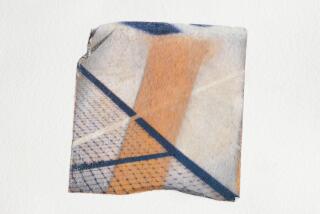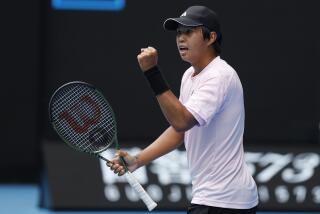Getting Back Into the Swing
Picture this as a reason to dust off your tennis game: The boss gets wind that you’ve played a fair amount of tennis over the years and invites you to bat the ball around. The problem is that you haven’t been on a tennis court in a long time and no doubt will make a fool of yourself.
I speak from experience, having been thrashed by older-boss types on several occasions, much to their unabashed delight. But I have a solution for such dilemmas, albeit a somewhat pricey one--the tennis lesson.
I’ve used this resource several times over the years, including times when I’ve gone on fitness jags and, more recently, to keep up with my children’s games. At one point several years ago, they were taking lessons three times a week and were soon powering backhands past me with embarrassing ease. I had to shell out for my own lessons in self-defense.
This time around, I did it as a first step in returning to the game, something I’d been meaning to do for a while. On the advice of a friend, I chose Will Moravec, the teaching pro at La Canada-Flintridge Country Club, located just off Angeles Crest Highway.
Though only 36, Moravec is a longtime fixture at the club, having worked there for the last 12 years. A native of Rancho Palos Verdes, he’s hit with tennis greats Pete Sampras and Andre Agassi and competed for Cal State Long Beach back in the days when it had a nationally ranked tennis team.
Moravec knows from experience that there are some clear divisions in people who take lessons and whether or not they are coachable. Children age 6 and up are perhaps the easiest to train because they have no preconceived notions and they follow directions. Teenagers, particularly boys, are almost impossible to train because they lack patience.
Then there is a gap with young adults, who are usually too busy beginning careers and families to take lessons. He said they begin to return to the game in their mid- to late 30s as a way of staying in shape.
“The most important thing about lessons is that they teach you how to avoid tennis elbow and they allow you to learn enough so that you can continue to grow as a player,” said Moravec as we walked down to the well-maintained court.
He said that a novice could lay a tennis foundation--serve and get the ball back and forth--with five or six lessons.
I clicked on my heart-rate monitor as I began some stretches, while Moravec explained that the best tennis players rally slowly at first, working on rhythm while muscles loosen. Then, as the warmup continues, they use more forceful strokes, ending with overheads and serves.
Moravec wheeled a basket of balls to the center of the court and began putting me through my paces. One thing I’ve learned from past experience is that lessons can be grueling, even for the best conditioned. But they also offer a fine workout because movement is almost constant, and hitting hundreds of balls eliminates any possibility of boredom. Moravec said several of his middle-age students value the exercise as much as the learning.
We started with some easy hits, with both of us at midcourt. Moravec noted immediately that I wasn’t dropping my racquet low enough on forehand strokes. Then I moved back to the baseline, taking a number of easy forehands and backhands. I looked at my heart-rate monitor and noticed that I was well above the 140 mark, the high end of my optimum range.
Then we began some more strenuous exercises in which I had to run from side to side, first returning forehands, then backhands, then alternating between the two.
After doing this for several minutes, I was winded but encouraged that my strokes were showing a bit more consistency. Finally we did overheads and serves, both of which were unremarkable in the extreme. Having said that, though, I felt as though I’d made some major progress.
Moravec said tennis is not as popular as it was a decade ago but is far ahead of the doldrums it suffered through in the ‘60s and early ‘70s.
The women’s game, in comparison with the men’s, is flourishing because of new stars such as the Williams sisters and Lindsay Davenport. The key, said Moravec, is to attract children away from computer games and back onto the court.
“The tennis world is trying to get to the younger generation,” he said.
The hour’s lesson went by too quickly. I packed up my tennis bag and we returned to the pro shop, where I wrote a check for $46. A pricey hour’s worth of exercise but worth it if it meant I was beginning to get a little of my game back.
*
(BEGIN TEXT OF INFOBOX)
Snapshot: Tennis
Where to go: Numerous tennis clubs throughout the Los Angeles area offer individual and group lessons, and many have summer youth programs. Also, city parks and recreation programs offer lessons. Fees vary according to instructor.
Duration of activity:
1 hour, 1 minute
Calories burned*: 577
Heart rate*: Average, 125 beats per minute; high, 165
Target zone: 115 to 140 beats per minute
Time in target zone*:
30 minutes, 57 seconds
*This information was obtained using a heart-rate monitor. Time in the target heart-rate zone is a measure of the intensity of the workout. Target zone varies based on age and individual heart rate.


